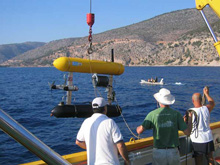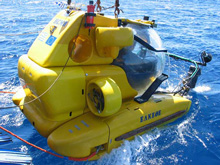The Greek national research vessel AEGAEO, operated by the Hellenic Centre for Marine Research, will be the support ship for Project PHAEDRA 2006. Click image for larger view and image credit.
Mission Plan
Brendan Foley & Dimitris Sakellariou
Chief Scientists
The scientific goals of Project PHAEDRA 2006 are three-fold, and fit the general categories of earth science, archaeology, and engineering. For the archaeological component, under the direction of archaeologists from the Hellenic Ministry of Culture’s Ephorate [Department] of Underwater Antiquities (EUA), the team will survey shipwreck sites selected by EUA discovered during joint EUA – HCMR research cruises.
A primary goal of the project is to develop new techniques and data products for archaeology, oceanography and geology. The team will deploy a suite of in-situ sensors mounted aboard a precision navigated robotic Autonomous Underwater Vehicle. Many of these sensors have never before been utilized by archaeologists or very rarely by oceanographers and geologists. The AUV’s sensors include a multibeam mapping sonar; high resolution digital cameras for photomosaic and site detail imaging. On board chemical sensors, including the Gemini mass spectrometer mounted on Thetis HOV, will quantitatively map concentrations of trace chemical components and their isotopes, including dissolved biogeochemical gases (i.e. oxygen, nitrogen, methane, carbon dioxide, hydrogen, hydrogen sulfide, argon) dissolved organic matter, chlorophyll, and petroleum hydrocarbons. Additionally, the team will deploy an experimental 150 kHz subbottom profiling sonar to acoustically image objects under sediments.
PHAEDRA’s geological / oceanographic objectives are to investigate the characteristics and geochemistry of active hydrothermal, venting sites in the volcanic field of Milos island, in the Columbo crater and in the caldera of Santorini. Together with the volcanic fields of Nisyros, Aegina, the Methana peninsula, and other minor volcanic centers, Columbo, Santorini and Milos are part of the concave Hellenic Volcanic Arc in the southern Aegean Sea. This arc parallels the active front of the Hellenic Orogenic Arc in the Eastern Mediterranean.
Milos volcanic field includes a number of presently active venting sites and several impressive volcanic craters on the island. Although no significant volcanic explosion occurred in the near geological past or in historical time, the seabed around the island is hydrothermally very active. Venting sites are located mainly southeast of Fyriplaka volcano as well as in the Adamas bay. Our aim is to relocate venting sites on the seafloor around Milos volcano and perform multitasking investigations, including in situ mass spectrometry using the Gemini mass spectrometer, sediment sampling, water sampling, temperature measurements, microbathymetry and photomosaic of the active sites.
Columbo is an active volcano, notorious for its explosive eruption in September 1650 A.D., which released ash, pumice fall and toxic gases. A strong tsunami, generated by this submarine explosion, propagated in the southern Aegean Sea. The wave devastated the coasts of the surrounding islands and killed fifty people. The 2006 PHAEDRA team will conduct precise bathymetric and chemical mapping of this volcano in order to provide geologists and vulcanologists with a better understanding of its structure and activity. Columbo’s cone slopes up from the surrounding sea floor (400 m) to a depth of 25 m at the shallowest point of the caldera rim. The circular rim of the crater has a diameter of approximately 2 km and a maximum depth at the center of 500 meters. The crater walls are very steep, and are composed of volcanic rocks (i.e. lava flows and pyroclastics).
Santorini is one of the most popular and worldwide known islands of the Aegean Sea. Santorini’s spectacular landscape is the result of a violent eruption, which took place in the 17th century BC. The so-called Minoan eruption devastated the island, changed dramatically the landscape of the island and was responsible for the formation of the caldera. It is believed that the Minoan eruption and the associated catastrophic phenomena like a possible giant tsunami, generated by the eruption and the collapse of the former volcanic cone are responsible for the decline of the Minoan civilization on Crete island. The presently active volcanic centre is located on a small island called Nea Kameni in the center of the caldera. Active hydrothermal vents have been observed at various sites on the seafloor of the caldera at depths up to 400m.
Data will be collected with the Gemini mass spectrometer mounted on Thetis. Gemini will determine the chemical signature of water seeping from different points in the volcano crater. These data will be used as baseline measurements for future surveys, and will also provide information about structural and chemical features of the volcano. The data will be compared with other active sites in the Hellenic Volcanic Arc system, and other volcanoes throughout the world. Water samples will be taken from the venting sites and will be analysed under a suitably configured gas chromatograph. Push-cores will be sampled from the sediments and hydrothermal deposits nearby the venting sites. Biological samples, like bacterial mat, will be sampled with a specially designed suction pump.PHAEDRA’s archaeological objectives are to determine the dates of the vessels as closely as possible; the dimensions of the wreck sites; and the nature of their cargoes. Interpretation of these data will help determine the cultural identity of the sailors and the vessels’ possible origins, intermediate port calls, and suspected ultimate destinations. We also will investigate and seek to characterize the environmental and preservative characteristics of the water and sediments around the wreck, and will experiment with new methods for chemical analysis; for instance, regressive carbonate analyses may allow the team to learn information about the nature of original organic cargo elements. We will interpret all of this information within the larger context of the period and cultures in question once those basic questions have been answered. These will be the first surveys of these sites; therefore, we anticipate that many new research questions and opportunities for scholarly inquiry will arise during this expedition.
Archaeology in deep water requires a heavy dose of technology. Reaching the sites will be possible only through the use of underwater vehicles. The systems we will use during this project include the Human Occupied Vehicle (HOV) Thetis, operated by HCMR; and the Autonomous Underwater Vehicle (AUV) SeaBED, from WHOI. Thetis can go as deep as 610 meters, and SeaBED can dive to 2000 m! The experience of investigating a shipwreck via robot or submersible is very different from scuba diving. The scientists can never actually touch the site themselves. All interaction with the site is mediated by the technology. We will ‘see’ the shipwreck only through the AUV’s digital camera images, its multibeam sonar maps, or through Thetis’ acrylic spherical pressure hull. These technologies at once enable us to glimpse into the past, but form barriers between us and the shipwrecks. One area we will explore during the 2006 PHAEDRA project is the cognitive experience of deep water archaeology: how does technology affect the way we understand shipwrecks?
The investigation of these archaeological remains and geological features can only be accomplished using deep submergence technology. A critically important but easily overlooked aspect of this technology is navigation – the capability of the robots and submersibles to determine where they are on the seafloor. Proper navigation makes possible the documentation and quantification that transforms exploration into scientific inquiry. Because GPS signals are not available underwater, the engineers on the PHAEDRA team will precisely navigate the underwater vehicles by merging information from a mix of sensors: acoustic transponder systems, Doppler Velocity Log, flux gate compass, and ring laser gyro. Combining these sensors’ data allows the team to put into context all of the information gathered by the on-board scientific instruments, and to place those measurements within globally referenced coordinates. This spatially fixed reference will allow scientists revisiting these sites to document changes over time – important for observing archaeological preservation and capturing the slow dynamics of geological processes. To accomplish this, the PHAEDRA engineers will employ new navigation techniques that eliminate much of the cost and complexity of previous methods.
Factors such as weather, sea state, and unforeseen technical difficulties (such as hardware damage, etc.) invariably disrupt any plan. Given the nature of operations in the deep sea, detailed hour-by-hour plans of work are impractical. Therefore, short term operational decisions will evolve as necessary while at sea. The WHOI and Hellenic Centre for Marine Research (HCMR) investigators each have extensive experience with deep sea operations and are well prepared to handle the inherent uncertainties of mission planning for this expedition. Stay tuned and learn what is happening during our mission by checking out our online daily logs!
Sign up for the Ocean Explorer E-mail Update List.




















